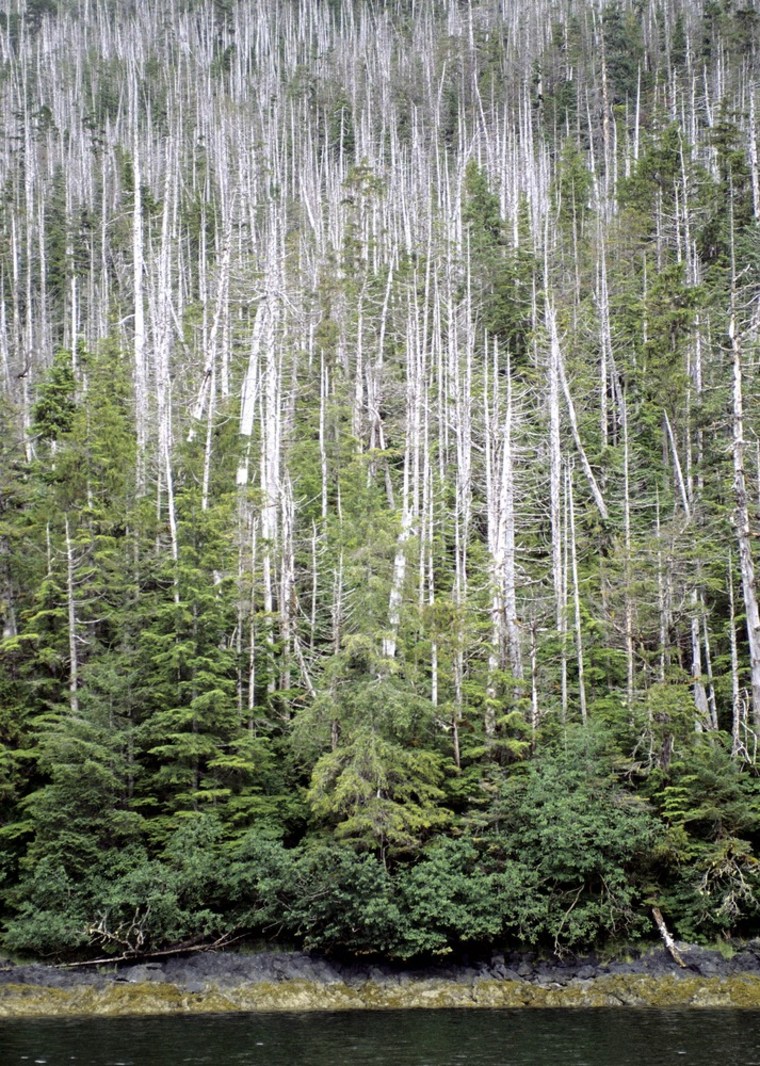U.S. Forest Service researchers have confirmed what has long been suspected about a valuable tree in Alaska's Panhandle: climate warming is killing off yellow cedar.
The mighty trees can live more than 1,000 years, resisting bugs and rot and even defending themselves against injury, but their shallow roots are vulnerable to freezing if soil is not insulated by snow. And for more than a century, with less snow on the ground, frozen roots have killed yellow cedar on nearly a half-million acres in southeast Alaska, plus another 123,000 acres in adjacent British Columbia.
The detective work on the tree deaths will help forest managers decide where yellow cedar is likely to thrive in the future. But the yellow cedar experience also underscores the increasing importance that climate change will play in managing forests, said Paul Schaberg, a USFS plant pathologist from Burlington, Vt., one of five authors of a paper on the tree that appeared this month in the journal Bioscience.
"As time goes on and climates change even more, other species, other locations, are likely to experience similar kinds of progressions, so you might do well to understand this one so you can address those future things," Schaberg said.
Yellow cedar and western red cedar are not the most common trees found in Alaska's coastal rainforest, but they were high-value commodities long before loggers arrived.
Tlingit, Haida and Tsimshian people used the rot-resistant wood for canoe paddles and totem poles. They could remove a lengthwise strip of bark from a living tree to use for weaving baskets and hats, and as backing in blankets. The remarkable tree could compartmentalize the injury and continue growing.
Yellow cedar is still valued for boat-building, but the bulk of the Alaska commercial harvest is sold in Asian markets, said Paul Hennon, a USFS forest pathologist from Juneau and one of the lead authors of the research paper. In Japan, it's valued for its age, tight grain and light color, Hennon said.
The slow-growing yellow cedar has trouble competing with western hemlock or Sitka spruce on well-drained, nutrient-rich soils. However, it was found a niche in soils with poor or moderate drainage — as long as its shallow, fine roots were covered by snow.
Those roots turned into an Achilles heel as snow patterns changed. Elevated mortality began around 1880-1890 and peaked in the 1970s and 1980s, according to the USFS study.
The yellow cedar's durability allowed dead trees to stand 100 years after they died but the cause of death was perplexing for years. Tree pathologists eliminated organisms or fungi as the primary cause and turned to physical factors such as hydrology and soil temperature, eventually linking yellow cedar decline to snow accumulation and duplicating results with seedlings.
"It's ironic that a species might be dying due to freeze-induced mortality when the climate signal is warming," Schaberg said. "So the world is getting warmer and these things are freezing? What's up with that?"
The conclusions have important implications for forest managers. They can predict where yellow cedar will thrive and the areas with poor drainage where yellow cedar has little chance to survive as snow patterns shift.
"That may seem counterintuitive to some folks, but one response is, you see a tree dying, you say, 'Oh, let's plant more,' without necessarily analyzing, well, why is it dying?" Schaberg said. "And if it really is a site that won't sustain the species, does it make any sense to put it there anymore?"
On the other hand, planting yellow cedar in areas that have good drainage, which would allow for deeper root growth, also would make sense. That would take some traditional forest management by eliminating competitors until yellow cedar had established itself.
"We can plant the tree on those sites, and also thin for it," Hennon said. "This is a place where active management can give yellow cedar a little bit of competitive edge, and then it does very well there."
Researchers also know that yellow cedar may thrive in areas where it has not yet migrated, leading to the possibility of "assisted migration."
"That gets some people pretty nervous, the idea of planting a species outside its range," Hennon said, because the tree could be considered an invasive species. The Forest Service conducted a trial planting near Yakutat, a coastal community northwest of Juneau, and saw a first-year survival rate of more than 90 percent. Since yellow cedar has already been found farther to the northwest in Prince William Sound, he doesn't consider the trial planting to be assisted migration.
In any case, climate change is likely to be more of a consideration for forest managers.
"I'm looking out my window and we have a dusting of snow at best," Schaberg said from his Vermont office. "And the soils are frozen all over the place, which is not the norm at all. So even just this one component of changing climate — reduced snow packs, its influence on soils and the things that are living in soils, like roots — that is not limited to the yellow cedar story and Alaska. That's pertinent to many locations."
